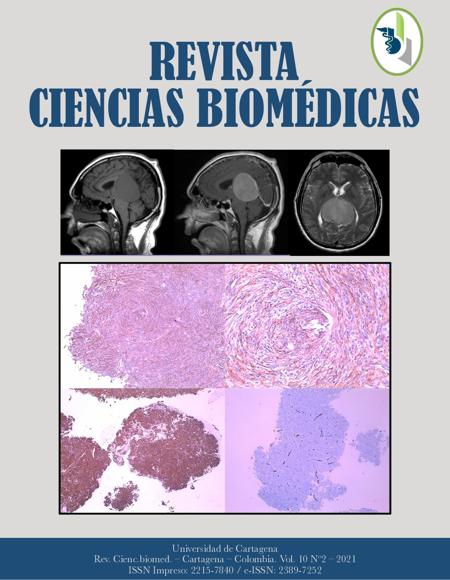Meningioma falcotentorial, una localización inusual : presentación de un caso en paciente masculino y revisión de la literatura.
Falcotentorial meningioma, an unusual location : case description in a male patient and literature review.
Contenido principal del artículo
Resumen
Introducción: los meningiomas representan los tumores cerebrales primarios más frecuentes. Hasta el 90% de los casos son tumores de bajo grado. Son más frecuentes en mujeres entre la cuarta y sexta década de la vida, con una relación hombre/mujer de 3:1. Caso clínico: se presenta el caso de un hombre en la sexta década a quien por medio de neuroimágenes se le demuestra una gran masa circunscrita de localización falcotentorial, con criterios radiográficos e histopatológicos de meningioma, caso que resalta por la presentación clínica tan elocuente y lo infrecuente de esta localización. Conclusiones: los meningiomas son tumores más frecuentes en mujeres, se encuentran comúnmente en la convexidad cerebral de localización supratentorial; las localizaciones variantes implican un reto diagnóstico siendo la localización falcotentorial extremadamente rara, con pocos informes de los hallazgos de imágenes en esta localización.
Palabras clave
Descargas
Datos de publicación
Perfil evaluadores/as N/D
Declaraciones de autoría
- Sociedad académica
- Universidad de Cartagena
- Editorial
- Universidad de Cartagena
Detalles del artículo
Referencias (VER)
Perry A, Louis DN, Budka H, von Deimling A, Sahm F, Rushing EJ, et al. Meningiomas. En: Louis DN, Ohgaki H, Wiestler OD, Cavanee WK, Ellison DW, Figarella-Branger D, et al, eds. WHO Classification of Tumours of the Central Nervous System (Revised 4th edition). IARC: Lyon 2016: 232-245.
Ostrom QT, Cioffi G, Gittleman H, Patil N, Waite K, Kruchko C, et al. CBTRUS Statistical Report: Primary Brain and Other Central Nervous System Tumors Diagnosed in the United States in 2012-2016. Neuro Oncol. 2019 Nov 1; 21(Suppl 5): v1-v100. doi: https://doi.org/10.1093/neuonc/noz150 DOI: https://doi.org/10.1093/neuonc/noz150
Anaya-Delgadillo G, Juambelz-Cisneros PP, Fernández-Alvarado B, Pazos-Gómez F, Velasco-Torre A, Revuelta-Gutiérrez R. Prevalencia de tumores del sistema nervioso central y su identificación histológica en pacientes operados: 20 años de experiencia. Cirugía y Cirujanos. 2016. https://doi.org/10.1016/j.circir.2016.01.004 DOI: https://doi.org/10.1016/j.circir.2016.01.004
Kshettry V, Ostrom QT, Kruchko C, Al-Mefty O, Barnett GH, Barnholtz-Sloan JS. Descriptive epidemiology of World Health Organization grades II and III intracranial meningiomas in the United States. Neuro-Oncology 2015; 17(8), 1166–1173. https://doi.org/10.1093/neuonc/nov069 DOI: https://doi.org/10.1093/neuonc/nov069
Ramos-Clason EC, Tuñón-Pitalua MC, Rivas-Muñoz FA, Veloza-Cabrera LA. Tumores primarios del sistema nervioso central en Cartagena, 2001- 2006. Rev. Salud Pública. 2010, 12 (2): 257-26. https://doi.org/10.1590/S0124-00642010000200009 DOI: https://doi.org/10.1590/S0124-00642010000200009
Dalle Ore CL, Magill ST, McDermott MW. Falcotentorial meningiomas. Handb Clin Neurol. 2020; 170: 107-114. doi: 10.1016/B978-0-12-822198-3.00033-1. PMID: 32586482. https://doi.org/10.1016/B978-0-12-822198-3.00033-1 DOI: https://doi.org/10.1016/B978-0-12-822198-3.00033-1
Talacchi A, Biroli A, Hasanbelliu A, Locatelli F. Surgical management of medial tentorial meningioma: falcotentorial and torcular. World Neurosurgery (2018), doi: https://doi.org/10.1016/j.wneu.2018.04.066 DOI: https://doi.org/10.1016/j.wneu.2018.04.066
Nowak A, Dziedzic T, Czernicki T, Kunert P, Marchel A. Falcotentorial and velum interpositum meningiomas: Two distinct entities of the pineal región. Neurologia i neurochirurgia polska 48 (2014) 397-402. https://doi.org/10.1016/j.pjnns.2014.09.009 DOI: https://doi.org/10.1016/j.pjnns.2014.09.009
Behari S, Das KK, Kumar A, Mehrotra A, Srivastava AK, Sahu RN, et al. Large/giant meningiomas of posterior third ventricular region: Falcotentorial or velum interpositum? Neurology India, May-Jun 2014 62(3):290-296. https://doi.org/10.4103/0028-3886.136934 DOI: https://doi.org/10.4103/0028-3886.136934
Quinones-Hinojosa A, Chang EF, Mcdermott MW. Falcotentorial meningiomas: clinical, neuroimaging, and surgical features in six patients. Neurosurg Focus 2003; 14 (6): 1-7. https://doi.org/10.3171/foc.2003.14.6.11 DOI: https://doi.org/10.3171/foc.2003.14.6.11
Claus EB, Black PM, Bondy ML, Calvocoressi L, Schildkraut JM, Wiemels JL, et al. Exogenous hormone use and meningioma risk: what do we tell our patients? Cancer. (2007) 110(3): 471-6. PMID: 17580362. https://doi.org/10.1002/cncr.22783 DOI: https://doi.org/10.1002/cncr.22783
Konovalov AN, Spallone A, Pitzkhelauri DI. Meningioma of the pineal region: a surgical series of 10 cases. J Neurosurg 85: 586-590, 1996. https://doi.org/10.3171/jns.1996.85.4.0586 DOI: https://doi.org/10.3171/jns.1996.85.4.0586
Asari S, Maeshiro T, Tomita S, Kawauchi M, Yabuno N, Kinugasa K, et al. Meningiomas arising from the falcotentorial junction. J Neurosurg 82: 726-738, 1995. https://doi.org/10.3171/jns.1995.82.5.0726 DOI: https://doi.org/10.3171/jns.1995.82.5.0726
Leyva-Pérez I, Guerrero-Avendaño G, Hernández-Paz JR. Meningiomas: apariencia por tomografía y por resonancia magnética. Localizaciones más frecuentes. Anales de Radiología México 2013; 1:36-44.
Miranda-Maldonado IC, Larralde-Contreras L, Niderhauser-García A, Barboza-Quintana O, Ancer-Rodríguez J. Clasificación morfológica de meningiomas en una casuística del Hospital Universitario Dr. José E González. Patología Rev Latinoam 2011;49(3):188-195.
Hong CK, Hong JB, Park H, Moon JH, Chang JH, Lee KS. Surgical Treatment for Falcotentorial Meningiomas. Yonsei Med J 2016 Jul;57(4):1022-1028. https://doi.org/10.3349/ymj.2016.57.4.1022 DOI: https://doi.org/10.3349/ymj.2016.57.4.1022
Rabadán AT, Hernández DA, Paz L. Hemangioblastoma located in the posterior incisural space mimicking a tentorial meningioma: a case report. Journal of Medical Case Reports (2016) 10:183. https://doi.org/10.1186/s13256-016-0962-z DOI: https://doi.org/10.1186/s13256-016-0962-z
Sadetzki S, Chetrit A, Turner MC, van Tongeren M, Benke G, Figuerola J, et al. Occupational exposure to metals and risk of meningioma: a multinational case-control study. J Neurooncol. 2016 Dec;130(3):505-515. https://doi.org/10.1007/s11060-016-2244-4 DOI: https://doi.org/10.1007/s11060-016-2244-4
Olar A, Wani KM, Sulman EP, Mansouri A, Zadeh G, Wilson C, et al. Mitotic index is an independent predictor of recurrence-free survival in meningioma. Brain Pathol 2015 May;25(3):266-75. https://doi.org/10.1111/bpa.12174 DOI: https://doi.org/10.1111/bpa.12174
Mawrin C, Perry A. Pathological classification and molecular genetics of meningiomas. J Neurooncol (2010) 99:379-391. https://doi.org/10.1007/s11060-010-0342-2 DOI: https://doi.org/10.1007/s11060-010-0342-2



 PDF
PDF
 FLIP
FLIP





